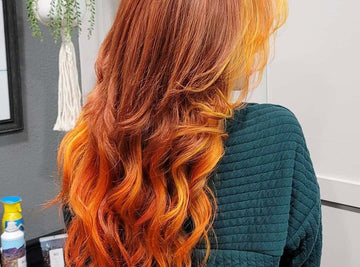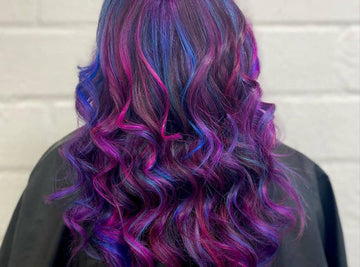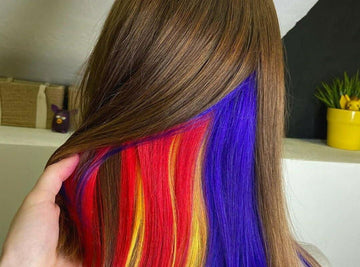Hair rebonding, also known as chemical straightening, entails transforming your hair’s natural concentration and can be a wonderful, basically as long way to get the straight hair you’ve always wanted. It is also time-consuming and challenging treatment. Hair rebound, wherein hair is chemically stimulated with considerable heat, is how you achieve smooth and straight hair.
To put it another way, hair rebonding entails chemically soothing your hair by trying to break down (and then restoring) these links back in order to alter the present structure of everything from your hair.
If you’ve pretty recently rebonded your hair, you might be curious to know how to ensure that it remains as stylish and straight as attainable.
Perhaps you have seen some splitting or dullness and want to get ahead of it. We’ve put up a variety of ways to manage your rebonded hair after it has been rebonded, so you can have the ideal results and maintain your hair healthy.
Tips on How to Take Care of Rebonded Hair

Use cold water when taking showers
Even though we encourage bathing your rebonded hair a little more than necessary, you can indeed take a shower to keep it clean and freshen up.
Shower using cold water at a compatible temperature in this regard. Specifically, taking cold showers aids in the retention of hair hydration while also preserving hair strands from potential damage. It also keeps hair lustrous and smooth.
Before bathing your hair, wait at least three days.
Your hair needs a few days to adjust to its truly innovative structure. For the greatest effects, keep it damp within a minimum of 3 days (approximately 72 hours) after the treatment. Because water might hinder your treatment’s benefits, it’s essential to preserve your hair clean and tidy.
It is suggested by experts because getting accustomed to the newly acquired structure takes time. Moreover, if you shower your hair during these days, you will not obtain the anticipated results. As a result, washing your hair only 2-3 times a week is better for rebonded hair.
Keep your hair down as much as possible and don’t scratch it.
Even after your hair has settled into its new form, it will remain dry and brittle. Stay away from hair bands, clips, and clamps for at least a couple of weeks to up to a month to avoid breaking or other damage. It will have a chance to recuperate as a result of this.
Since your hair really becomes dry and brittle after Rebounding, it deserves the utmost care and maintenance. Hair should not be knotted or placed behind the ears for perhaps the first month because it could prevent from achieving great results.
Hair that has been rebonded should be deep-conditioned.
Thorough conditioning is an important part of the rebonded hair restoration process. Deep conditioning product lines are thick and used for a long period, which is the sole difference between them and conventional conditioners.
Excessive chemical use during the rebonding process causes hair to become brittle. Deep conditioning improves hair texture and softens hair shafts, restoring your natural shine.
You should thoroughly moisturize your hair after just rebonding and at least twice weekly after showering. As a result, it’s best when you do it the same day you wash your hair. There are also some conditioner products accessible online, as well as natural substances that can be used to make deep conditioners.
Use a shampoo that is free of sulfates.
Sulfate-free shampoos may improve the retention of hydration and suppleness in your hair. Sulfates, which are good cleansing compounds that help eliminate dirt and impurities, are found in many shampoos. However, because they take natural oils from your hair, they can dry everything out and leave it drier.
There are also particular shampoos made for smoothed or treated hair, in addition to sulfate-free shampoos. Some shampoos, for example, include extra vitamins or strengthening elements like keratin.
You might want to use a purifying conditioner, which is gentler and won’t remove all of your hair’s natural oils.
Here are several lists of shampoos that you may use in maintaining your rebonded hair.
Moroccan Argan Oil Shampoo and Conditioner

Penetrates the skin and increases moisture levels in the body. This shampoo features a UV and Thermal Protectant, as well as Vitamins and Antioxidants, to nurture and repair hair damaged by habitual use of such a hairdryer, straightening iron, curling iron, or hair that has been chemically treated.
Love Beauty And Planet Sulfate-Free Deep Cleanse, Hydrate, Strengthen, Volumize & Shine Vegan Biotin & Sun-Kissed Mandarin

This sulfate-free shampoo has five revitalizing properties: it thoroughly detoxifies, soothes, strengthens, adds volume, and actually leaves hair soft and silky.
Aveeno, Fresh Greens Blend Sulfate-Free Shampoo with Rosemary, Peppermint & Cucumber to Thicken & Nourish, Clarifying & Volumizing Shampoo

Peppermint, cucumber, and rosemary are integrated for a refreshing fragrance. It also promotes natural hair beauty, making your rebonded hair look more natural. It’s sulfate-free, dye-free, and paraben-free, and it’s safe for color-treated and chemically transformed hair.
Verb Ghost Shampoo

Weightless conditioning, color protection, and blemish hair are all significant advantages of the Verb Ghost Shampoo. Moringa oil feeds critical nutrients into the hair shaft, naturally smoothing imperfections for all types of hair.
Cantu Sulfate-Free Cleansing Cream Shampoo

Cantu sulfate-free bathing shampoo is excellent for curly and wavy hair. Thoroughly washes hair and scalp, promoting hair to grow while reducing damage with this unique sulfate-free product.
Using the right heat settings, blow-dry the hair.
Considering your rebonded hair must be maintained dry at all times, blow drying is a must. We advise against doing anything that will make your hair humid and moist. Wet hair is an impediment that will destroy your hair and make you spend more money.
Furthermore, after showering and thorough moisturizing, you should blow your hair with a high-quality blow dryer that uses tourmaline advanced technologies. Hair drying must be done in suitable conditions for rebonded hair. the rebonding technique is carried out in extremely high temperatures. As a result, if your hair is dried in a hot setting, it is worn down easily.
Use a comb with a wide edge.
Combs with wide teeth are softer on your hair. With increased space between the teeth, they create less tugging and stress, resulting in less breakage. They also have a lower cost.
You must also avoid brushing wet hair because it is more sensitive as a result of cuticle damage.
It’s easier to untangle because of the broad spacing between the teeth, so there’s less hair-splitting. When equated to an intermediate tooth comb, a broad tooth comb has less friction, making it soft for the hair strands and minimizing breaking and split ends.
You’ve probably noticed how fantastic a good wide tooth comb makes it feel on your scalp if you’ve used one previously. When you use a wide-tooth comb to brush your hair, your scalp will feel comforted and pampered rather than scratched cruelly, as it will when you use a regular comb.
Massage your scalp with a pretty wide-toothed comb to increase circulation and soothe a fatigued scalp.
Every week, steam your hair
You should steam your own rebonded hair once every 15 days. When you wash your hair less and dry it more, it becomes dry and brittle, and it loses its sparkle. Steaming your hair also helps to keep your scalp healthier and opens up hair follicles for greater moisture absorption. Regarding rebonding, hair specialists advise against using a steaming machine in saloons, preferring to do it in any straightforward way.
Here are a few steps to help you steam your hair:
Step 1: Warm water should be used to wet a towel.
Step 2: 1-2 pumps of hair serum should be used.
Step 3: Once the towel is dry, moist heat it and wraps it around your head.
Step 4: Wait 30 minutes before unwrapping it; this will deep-condition your hair.
Step 5: Hair should be blow-dried or air-dried.
Your hair should not be dyed or bleached.
Hair dyeing or bleaching might result in additional dryness and breaking. Continued chemical treatments should be avoided in general, but especially shortly pre or post the rebonding, since they can result in protein breakdown and fiber degradation. If you still have to dye your hair, a demi-permanent bleach is a gentler option because the dye just reaches the cuticle and does not damage the hair.
Both the coloring and rebonding chemicals contain alkali, which is regarded to be harmful to the hair since it will oxidize. If you get your hair dyed and straightened on the same day, the process can be done again, resulting in irreparable hair damage.
At Regular Time points, Trim Hair
Trimming is an important element of hair care, especially if you have rebonded hair. After the strands have been rebonded, it is necessary to trim the split ends periodically.
Hair strands have the potential to progress out faster and in a positive manner if they are regularly trimmed. As a result, go to your chosen salons for trimming on a regular basis, such as every 6-8 weeks.
How long does it take to rebond your hair?
It takes approximately six hours to rebond. It’s a long process, but it’s necessary for the treatments to work. Bring your favorite book or stream your favorite show on your phone all while waiting to avoid boredom.
What is the duration of the rebonding treatment?
Depending on the condition of such hair rebonding procedure you received, it can last up to six months. You’ll need to return to the salon for a touch-up after six months so that the hair growth that has cultivated looks as totally straight as the rebonded proportion.
When is the finest time to have your hair rebonded?
You can have it at any time, technically speaking. You probably shouldn’t be allowed to rinse your hair over three days just after treatment, though. Because it’s so hot in the summer and you’re guaranteed to sweat profusely a lot, it’s best not to get your hair rebonded throughout that time.
Furthermore, you can’t knot your hair with anything for the next three months (assuming you want a funny curve in the center of your straight hair—which, by the way, will never ever go away.) So you won’t feel really uncomfortable after the procedure, consider your rebonding treatment throughout cold months like November or December.
Read More:
Can you curl your hair after keratin treatment?






